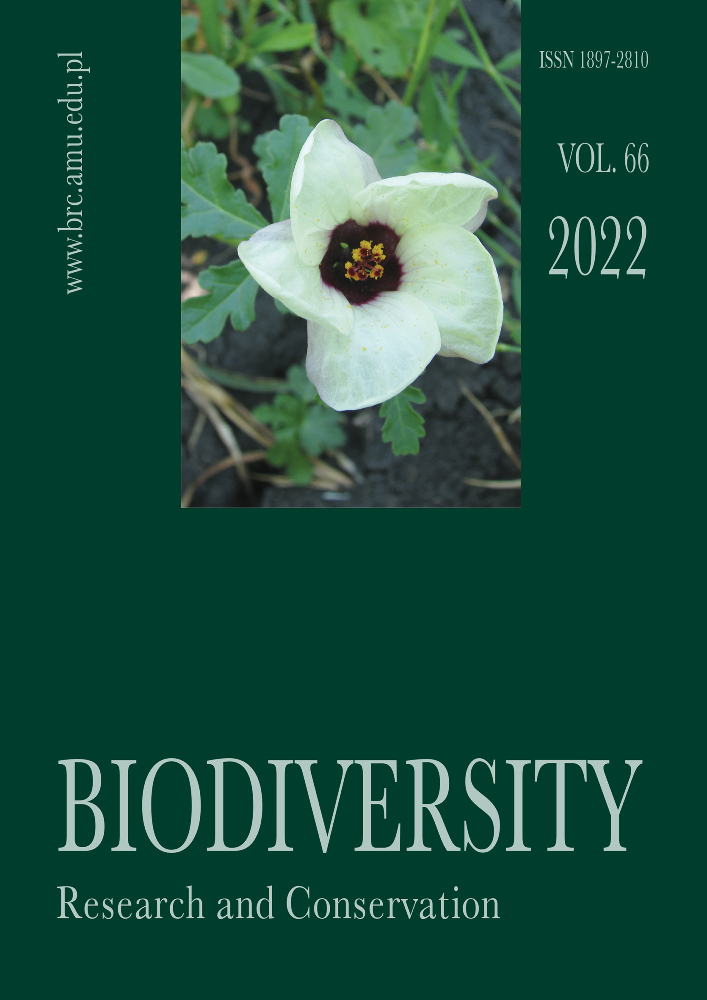Abstract
A study on the importance of wind-induced canopy gaps was conducted in Kampinos National Park (Poland) between2018 and 2021. Two types of habitats were considered – dry mesotrophic oak forest and wet Scots pine forest (Molinio- Pinetum). Canopy gaps were characterized by higher plant species richness than in adjacent areas, and their effect was weaker in oligotrophic coniferous forest than in mesotrophic deciduous oak stand.
Funding
This research was financed by the Forest Fund of the State Forests in 2020-2021.
References
Catford J. A., Daehler C. C., Murphy H. T., Sheppard A. W., Hardesty B. D., Westcott D. A., Rejmánek M., Bellingham P. J., Pergl J., Horvitz C. C. & Hulme P. E. 2011. The intermediate disturbance hypothesis and plant invasions: Implications for species richness and management. Perspect Plant Ecol Evol Sys 14: 231-241.
Chabrerie O., Verheyen C., Saguez R. & Decocq G. 2008. Disentangling relationships between habitat conditions, disturbance history, plant diversity, and American black cherry Prunus serotina invasion in a European temperate forest. Divers Distrib 14: 204-212. Chabrerie O., Loinard J., Perrin S., Saguez R. & Decocq G. 2010. Impact of Prunus serotina invasion on understory functional diversity in an European temperate forest. Biol Invasions 12: 1891-1907.
Dobrowolska D. 2006. Warunki mikroklimatyczne w lukach w drzewostanach mieszanych w rezerwacie Jata. Leśne Prac. Bad. 3: 45-56.
Dobrowolska D. 2010. Rola zaburzeń w regeneracji lasu. Leśne Prac. Bad. 71: 391-405.
Godefroid S., Phartyal S. S., Weyembmbergh G. & Koedam N. 2005. Ecological factors controlling the abundance of non-native invasive black cherry Prunus serotina in deciduous forest understory in Belgium. Forest Ecol Manag 210: 91-105.
Gutowswski J., Bobiec A., Pawlaczyk P. & Zub K. 2004. Drugie życie drzewa. WWF Polska. Warszawa-Hajnówka.
Halarewicz A. & Żołnierz L. 2014. Changes in the understorey of mixed coniferous forest plant communities dominated by the American black cherry (Prunus serotina Ehrh.). Forest Ecol Manag. 313: 91-97.
Hejda M. 2012. What is the impact of Impatiens parviflora on diversity and composition of herbal layer communities of temperate forests? PlosOne 7: e39571.
Hiura T. 1995. Gap formation and species diversity in Japanesebeech forests: a test of the intermediate disturbancehypothesis on a geographic scale. Oecologia 104: 265-271.
Holeksa J. 1998. Rozpad drzewostanu i odnowienie świerka a struktura i dynamika karpackiego boru górnoreglowego. Monographiae Botanicae. 28: 1-209.
Holeksa J. 2003. Relationship between field-layer vegetation and canopy openings in a Carpathian subalpine spruce forest. Plant Ecol 168: 57-67.
Holeksa J., Żywiec M., Bogdziewicz M., Kurek P., Milne-Rostkowska F., Piechnik Ł. & Seget B. 2021. Microsite-specific 25-year mortality of Norway spruce saplings. Forest Ecol Manag 498: 119572.
Kapusta P., Kurek P., Piechnik Ł., Szarek-Łukaszewska G., Zielonka T., Żywiec M. & Holeksa J. 2020. Natural and human-related determinants of dead wood quantity and quality in a managed European lowland temperate forest. Forest Ecol Manag 459: 117845.
Kassambara A. 2020. ggpubr: 'ggplot2' Based Publication Ready Plots. R package version 0.4.0. https://CRAN.R-project.org/package=ggpubr.
Kassambara A. 2021. rstatix: Pipe-Friendly Framework for Basic Statistical Tests. R package version 0.7.0. https://CRAN.R-project.org/package=rstatix.
Kurek P. 2019. Topsoil mixing or fertilization? Forest flora changes in the vicinity of badgers’ (Meles meles L.) setts and latrines. Plant Soil 437: 327-340.
Kurek P. & Cykowska-Marzencka B. 2016. Badger Meles meles setts and bryophyte diversity: A newly found role for the game animal in European temperate forests. Forest Ecol Manag 372: 199-205.
Kurek P., Sparks T. H. & Tryjanowski P. 2015. Electricity pylons may be potential foci for the invasion of black cherry Prunus serotina in intensive farmland. Acta Oecol 62: 40-44.
Muscolo A., Bagnato S., Sidari M. & Mercurio R. 2014. A review of the roles of forest canopy gaps. J For Res 25: 725-736.
Operat Ochrony Ekosystemów Leśnychna okres 01.01.2002 – 31.12.2021. 2002. BULiGL, Warszawa.
Orczewswska A. 2009. Migration of herbaceous woodland flora into post-agricultural black alder woods planted on wet and fertile habitats in south western Poland. Plant Ecol 204: 83-96.
Piskorz R. & Klimko M. 2001. Kolonizacja powalonych drzew i buchtowisk dzików przez Impatiens parviflora dc. w zbiorowiskach Galio silvatici-carpinetum wybranych rezerwatów Wielkopolskiego Parku Narodowego. Rocz. AR Pozn. 134, Bot. 4: 151-163.
R Core Team 2021. R: A language and environment for statistical computing. R Foundation for Statistical Computing, Vienna, Austria. https://www.R-project.org/.
Staniaszek-Kik M. & Żarnowiec J. 2013. Inwazyjne antropofity na murszejącym drewnie i wykrociskach w lasach Karkonoszy. Inż. Ekol. 32: 156-163.
Stokland J. N., Siitonen J. & Jonsson B. G. 2012. Biodiversity in dead wood. Cambridge University Press.
Šmilauer P. & Lepš J. 2014. Multivariate analysis of ecological data using CANOCO 5. Cambridge University Press.
Townsend C. R. & Scarsbrook M. R. 1997. The intermediate disturbance hypothesis, refugia, and biodiversity in streams. Limnol Oceanogr 42: 938-949.
Wickham H., Averick M., Bryan J., et al. 2019. Welcome to the tidyverse. J Open Source Software 4: 43, 1686,
Yamamoto S. I. 2000. Forest gap dynamics and tree regeneration. J For Res: 223-229.
Zacharyasiewicz M., Napierała A., Kurek P., Grossmann K. & Błoszyk J. 2021. Is biodiversity of Uropodina mites (Acari: Parasitiformes) inhabiting dead wood dependent on the tree species? Diversity 13: 609.
License

This work is licensed under a Creative Commons Attribution-NonCommercial-NoDerivatives 3.0 Unported License.





